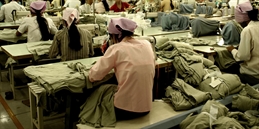
Offsetting the optimism about Cambodia as an emerging market is a strong awareness that it is a challenging place for logistics, the recent 17th ASEAN Ports and Shipping Conference in Phnom Penh heard.
The biggest challenge is not so much the lack of hardware – although that is a problem – but one of geography. Most of Cambodia’s manufacturing, and many of its consumers, are based in Phnom Penh, the capital city which is some 240 kilometres northeast of the gateway port at Sihanoukville.
Complicating this distance is the lack of decent land transport. An entirely new highway, expected to cost some US$1.9 billion, linking the capital with the coast, is being built and should be completed in 2023.
Cambodia has two railway lines, both from the capital: one to the gateway port at Sihanoukville and the other to Poipet on the border with Thailand. The 266 kilometre Phnom Penh to Sihanoukville track is single gauge; the 386 kilometre line to the Thai border is also single gauge, but does not yet operate fully and has no cargo capacity.
This means moving containers to Sihanoukville is complicated, expensive and time-consuming, Sopheak Ou, director of the Cambodia Freight Forwarders Association (CAMFFA), told the conference.
“The cost is very dear,” she said, adding later it was “as much” as going all the way by truck.
The three-stage process of moving a container from a factory to the railway in Phnom Penh and then to the port in Sihanoukville means there is no time advantage to using rail. “It's eight to 10 hours, even 12 hours real-time, trucking time,” Ou said. (Lest we forget, that’s for less than 300 kilometres in distance.)
Complicating this is a lack of trucks, drivers and other facilities to do the moving at either end of the railway. “We still don’t have a multi-modal transfer lane, and it’s a challenge,” Ou said.
Nor is the software much better, with the lack of legal clarity being a well-known problem.
Despite signing a deal with the Thai government to open the Poipet line to cross-border trade in April, basic rules on technical standards and specifications, a railway infrastructure bill and railway business laws are still lacking in Cambodia. “We need to have laws to have more opportunity,” Ou said.
Part of the way forward is to find experts to draft laws, she said. Some help is at hand as the Ministry of Public Works and transport is hoping to have two officials from the Korean International Cooperation Agency seconded to the ministry to help it tackle the issue.
In terms of hardware, multi-modal transfer facilities are needed, she said, and the government should find funds – although she acknowledged, it will be difficult for Cambodia to raise the money necessary to implement its rail master plan.
The master plan calls for five main lines, including the two already in operation, along with eight branch lines, four high-speed lines and an unspecified number of industrial lines. Government sources were not available for more information.
Sihanoukville as a port brings many of its own challenges, although some of these are caused by the basic imbalance of imports and exports and mention congestion caused by 7.5% growth over the past 10 years. Exports grew 7.8% last year while imports grew by just under double or 15.3%, Primo Ye, Cambodia country manager for Maersk told the conference.
Adding to the complexity of this, exports are bound to countries such as the United States, the United Kingdom and the European Union, while imports are heavily dominated by China.
Ye outlined five other, more immediate, challenges.
One is the lack of infrastructure, such as rail, needed to tackle road congestion and to support the growth of the business. This is compounded by other capacity shortages such as in human resources, which means productivity and efficiency are, as he diplomatically put it, “still not standard.”
Another factor weighing on the situation is the tensive nature of the garment supply chain, which is a big issue as the industry accounts for close to 90% of exports.
Complicating this is the need for shorter and shorter lead times as fast fashion becomes even faster. Cambodia also has to import all the materials used in the industry, making the supply chain even tighter.
The other problem he identified was the issue of weekly sailings, which “everyone fighting for the trucks Thursday and Friday,” but the same trucks being free on Monday and Tuesday, said Ye.
Some of these concerns may be met by a plan being developed by the Sihanoukville Autonomous Port for a new container terminal, which would bring significant new infrastructure, including a berth of 350 metres with a draft of 14.5 metres and an area of 175 hectares, as well as three quay cranes and nine rubber-tyred gantry cranes, into play.
Work on the terminal is due to begin next year, with completion due for 2023 and the US$203 million price-tag to be covered by a soft loan from the Japanese government.
By Michael Mackey
Southeast Asia Correspondent | Phnom Penh




